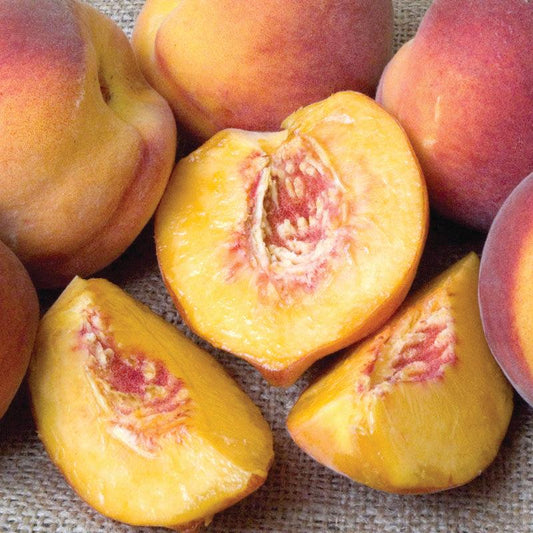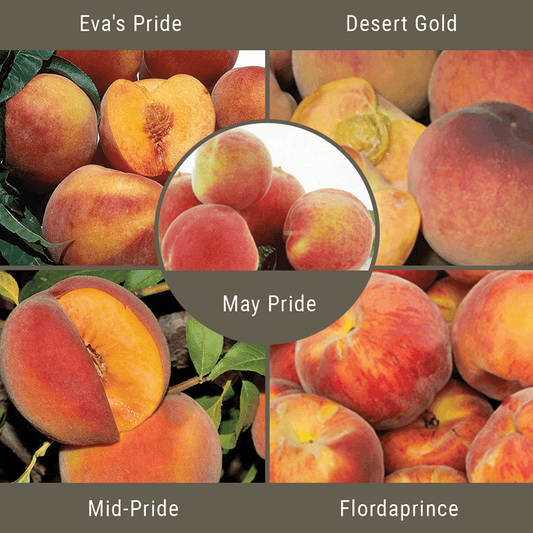Peach Tree Growing Zone Guide: Best Peach Tree Zone 9 Varieties & Care Tips
Growing peaches in warm climates can be incredibly rewarding, especially if you live in USDA Zone 9, one of the most favorable regions within the peach tree hardiness zone range.
With its long, warm summers and mild winters, Zone 9 provides ideal conditions for cultivating zone 9 fruit trees like peaches. These favorable temperatures make growing peach trees easier than many gardeners expect—especially when you choose the right variety, understand the chill hour requirement, and plant in well-prepared, draining soils that promote healthy root growth.
Whether you’re planting your first peach tree or expanding your backyard orchard, this guide will walk you through everything you need to know about selecting the best peach varieties, mastering proper planting techniques, and ensuring long-term success within your peach tree hardiness zone.
If you’re not sure whether you’re in Zone 9, you can quickly check here: What Is My Growing Zone?

Understanding Zone 9 Growing Conditions
What Makes Zone 9 Ideal for Peach Trees?
Zone 9’s climate supports healthy peach tree development from the first year of planting through full maturity. The long growing season helps peaches size up and develop full flavor, while mild winters still allow many zone 9 peach trees to meet their chill needs. With consistent sunlight and warm temperatures, peach trees can grow vigorously and establish a strong root system, which is essential for long-term health and productivity.
The warm climate also encourages early blooms and earlier harvest periods, which is great if you want peaches before midsummer. Some dwarf peach trees even begin to produce fruit in their second year, especially when grown in ideal conditions.
Challenges of Peach Tree Zone 9 Growing
Though Zone 9 is well-suited for peaches, there are a few important challenges to manage:
- Heat Waves: Extremely high temperatures can stress the tree, making consistent watering essential.
- Fungal Issues: Humid winters can worsen problems like peach leaf curl and bacterial leaf spot.
- Pests: Warm climates attract insects such as aphids, scale, mites, and peach tree borers.
- Soil Issues: Heavy clay soils that don’t drain well can cause root rot.
Fortunately, most of these issues can be prevented or managed with good cultural practices, proper pruning, and careful monitoring during the growing season.

When to Plant Peach Trees in Zone 9
The best time to plant peach trees in Zone 9 is from January through March, when trees are dormant. Planting at this time allows your peach tree to settle into the soil and build root strength without competing with top growth.
Dormant planting also reduces transplant shock and encourages earlier establishment. Because Zone 9 heats up quickly in spring, planting too late can stunt a young tree’s early growth and make watering more demanding.
If you’re interested in growing peaches from seed, here’s a step-by-step guide: Planting Peach Seeds Step-by-Step
Best Peach Trees for Zone 9
Selecting the best peach tree for zone 9 starts with choosing varieties that match your climate’s chill hours and perform reliably in warm-weather regions. Below are top performers known for great flavor, strong productivity, and consistent success.
Red Baron Peach (250–300 Chill Hours)
- Striking double red blossoms
- Juicy, firm, sweet fruit
- Perfect for warm climates and small spaces
Find it here: Red Baron Semi-Dwarf Peach Tree
J.H. Hale Peach (800 Chill Hours)
This variety thrives in slightly cooler microclimates within Zone 9 and rewards patient growers.
- Large, richly flavored fruits
- Traditional peach taste
- Excellent for canning and fresh eating
View it here: J.H. Hale Peach Tree
Redhaven Peach (800 Chill Hours)
- Yellow flesh and consistent yield
- Great balance of sweetness and acidity
- Popular among home gardeners
Buy it here: Redhaven Peach Tree
Low-Chill Multi-Grafted Peach Tree (100–150 Chill Hours)
Perfect for gardeners who want to maximize variety in a small space.
- Several peach types on one tree
- Longer harvest season
- Extremely low chill requirement
Explore it here: Low-Chill Multi-Grafted Peach Tree
Browse all available options here: Bare Root Peach Trees

How to Plant a Peach Tree in Zone 9
Choosing the Best Planting Site
Peach trees need full sun—at least 6–8 hours daily—to develop high sugar levels and high quality fruit. Choose a location with good air circulation and avoid low-lying areas where cool air settles.
Step-by-Step Planting Instructions
- Dig a hole twice as wide as the root ball.
- Ensure the hole is no deeper than the roots to prevent settling.
- Position the tree with the graft union 2–3 inches above soil level.
- Backfill with native soil; avoid heavy fertilizer at planting time.
- Water deeply to help the soil settle around the roots.
- Apply mulch around the tree but keep it off the trunk.
For watering details, especially for newly planted peach trees, see: How Often Should You Water a Newly Planted Peach Tree?
Aim for about one inch of water per week during the first year.
Caring for Peach Trees in Zone 9
Watering
Consistent, deep watering helps prevent stress during hot months and supports steady growth. Avoid shallow watering, which encourages weak roots.
Fertilizing
Peach trees grow quickly and benefit from early spring feeding. Proper fertilizing ensures better fruit size, leaf growth, and overall vigor.
Learn how here: Guide to Fertilizing Peach Trees
Pruning
Prune in winter to shape the tree and maintain an open center. Sunlight penetration is essential for good fruit color and flavor.

Managing Pests and Diseases
Zone 9’s warm weather can attract:
- Peach tree borers
- Aphids
- Ants
- Mites
Common diseases include:
- Peach leaf curl
- Bacterial leaf spot
- Brown rot
Useful guides:
Fruit Ripening and Harvest in Zone 9
Most peach trees for zone 9 begin ripening fruit from late spring to midsummer. Low-chill varieties tend to ripen earlier, while mid- and late-season types extend the harvest through July or even August.
For harvest timing, see: When Are Peaches in Season?
Conclusion
Growing peach trees in Zone 9 is both rewarding and achievable when you choose the right varieties, plant at the proper time, and provide consistent care. With mild winters, long sunny days, and the right attention to watering, pruning, and soil health, you can enjoy an abundant harvest of sweet, flavorful peaches right from your backyard.
By selecting low-chill varieties suited to your peach tree hardiness zone and maintaining healthy growing conditions, your Zone 9 peach trees will thrive for years—bringing the taste of summer to your garden season after season.
Whether you want classic yellow peaches, fragrant white flesh varieties, or compact dwarf varieties, Zone 9 offers endless potential for success.










1 comment
This was a very informative article! I’m saving it so I can dig deeper into each section! Thank you!